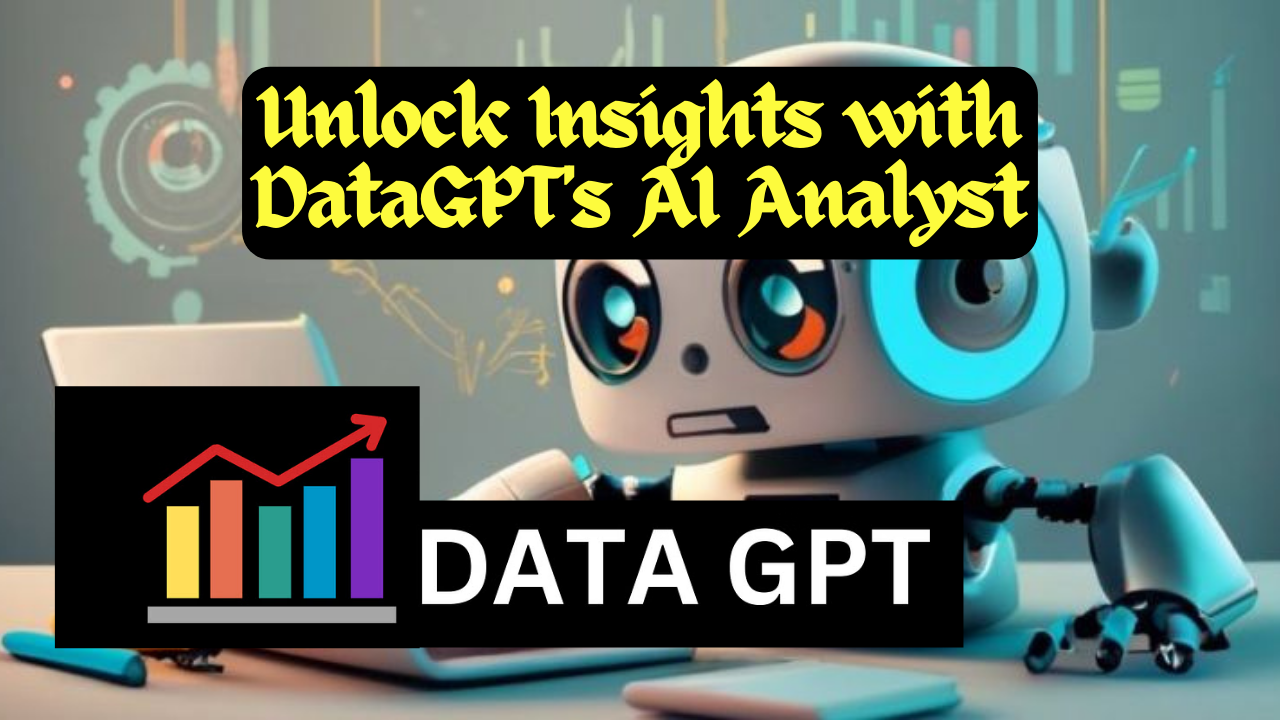Welcome to the future of data analysis, where conversations with your data are as easy as chatting with a colleague. In a world driven by data, extracting insights has traditionally been a complex, time-consuming endeavor. But now, thanks to California-based startup DataGPT, that's changing. DataGPT has unveiled its revolutionary AI Analyst, a game-changing tool that combines conversational AI with advanced analytics to help enterprises derive insights from their data effortlessly. In this article, we'll delve into how DataGPT's AI Analyst works and explore the remarkable benefits it brings to businesses. Say goodbye to the labyrinthine world of data analysis and embrace a new era of simplicity, speed, and efficiency.
DataGPT, the California-based startup, has unveiled its revolutionary AI Analyst, which is set to transform the way enterprises extract insights from their data. This article dives deep into how DataGPT's AI Analyst works and the multitude of benefits it offers to businesses.
How DataGPT's AI Analyst Works
DataGPT's AI Analyst simplifies the process of obtaining insights from data through a chatbot-style conversational experience. It consists of two key elements:
1. AI Analyst: The chatbot component that accepts natural language questions, processes queries, and provides immediate access to relevant insights.
2. Data Navigator: This component offers a more traditional approach by displaying visualizations of key metrics' performance and allowing manual data exploration.
DataGPT sets itself apart with its analytical engine, combining contextual comprehension from language models with deep data analysis and interpretation.
Benefits for Enterprises
Enterprises embracing DataGPT's AI Analyst have reported numerous advantages:
Accelerated Insights: The chatbot-style interface speeds up insight acquisition, enabling quicker decision-making.
Time Savings: Automation of data queries and analysis frees up analysts' time, allowing them to focus on more strategic tasks.
Performance: DataGPT's lightning cache database outperforms traditional databases, running queries up to 600 times faster than standard business intelligence tools.
Cost Efficiency: It reduces the cost of data analysis by up to 15 times, providing cost-effective insights.
Revenue Growth: DataGPT's insights can unlock up to 15% revenue growth for businesses.
The 3 Layers of the AI Analyst
Data Store: Stores the data schema, enabling the system to understand the data structure and relationships.
Core Analytics Engine: Executes analysis tasks, including computing impacts, employing statistical tests, and calculating confidence intervals.
Analyst Agent: Powered by a self-hosted large language model (LLM), this component creates a task plan based on user queries and delivers results in a conversational format.
Future Plans for DataGPT
DataGPT, backed by $10 million in pre-seed and seed rounds, is committed to expanding its analytical capabilities. Future enhancements include cohort analysis, forecasting, and predictive analysis, positioning DataGPT to remain competitive in the evolving data ecosystem.
Embrace the future of data analysis with DataGPT's AI Analyst. It's not just about understanding data; it's about having a conversation with it.
#DataGPT #AIAnalyst #DataAnalysis #BusinessInsights
Conclusion: DataGPT's AI Analyst
DataGPT's AI Analyst marks a significant leap forward in the realm of data analysis. It revolutionizes the way enterprises interact with their data, making the process more accessible, efficient, and insightful than ever before. By seamlessly integrating language understanding capabilities with a powerful analytics engine, DataGPT empowers users to have natural language conversations with their data.
The benefits are clear: accelerated insights, time savings, improved performance, cost efficiency, and the potential for revenue growth. As businesses strive to make data-driven decisions in an increasingly data-rich world, tools like DataGPT's AI Analyst are invaluable assets.
With future plans to enhance its analytical capabilities, including cohort analysis, forecasting, and predictive analysis, DataGPT is poised to stay at the forefront of the data analysis industry. As the demand for conversational AI-driven data analysis grows, DataGPT stands ready to empower companies to engage in meaningful conversations with their data, bridging the gap between data and informed decision-making. The future of data analysis is here, and it's all about having a conversation with your data.
Frequently asked questions (FAQs) about DataGPT's AI Analyst:
1. What is DataGPT's AI Analyst?
DataGPT's AI Analyst is a revolutionary chatbot-style tool that enables users to interact with their data using natural language. It simplifies the process of extracting insights from data and offers a user-friendly conversational experience.
2. How does DataGPT's AI Analyst work?
The AI Analyst comprises two key components: the AI analyst (chatbot) and the data navigator. Users can input questions in natural language, and the system provides immediate access to relevant insights. The data navigator displays visualizations of key metrics' performance, allowing manual exploration of data.
3. What sets DataGPT's AI Analyst apart from other data analysis tools?
DataGPT's AI Analyst differentiates itself with its analytical engine, which combines contextual comprehension from language models with deep data analysis. This results in a more comprehensive and user-friendly data experience compared to traditional BI solutions.
4. What benefits do enterprises gain from using DataGPT's AI Analyst?
Enterprises that adopt DataGPT's AI Analyst enjoy several advantages, including accelerated insights, time savings, improved performance, cost efficiency, and the potential for revenue growth. The tool can reduce data analysis costs by up to 15 times.
5. Is DataGPT's AI Analyst suitable for businesses of all sizes?
Yes, DataGPT's AI Analyst is designed to be accessible to businesses of all sizes. It empowers companies to make data-driven decisions efficiently, making it a valuable asset for both small startups and large enterprises.
6. How fast is DataGPT's lightning cache database compared to traditional databases?
DataGPT's lightning cache database is significantly faster than traditional databases, running queries up to 600 times faster than standard business intelligence tools. This speed can greatly enhance the efficiency of data analysis.
7. Can DataGPT's AI Analyst be used to analyze data in different languages?
Yes, DataGPT's AI Analyst supports over 95 languages, thanks to its integration with OpenAI's GPT-3.5 and GPT-4 language models trained on publicly available internet data.
8. Are there plans for future enhancements of DataGPT's AI Analyst?
Yes, DataGPT plans to expand its analytical capabilities in the future. This includes features like cohort analysis, forecasting, and predictive analysis. While the exact timeline for these capabilities is not disclosed, DataGPT aims to remain competitive in the evolving data analysis market.
9. How can I get started with DataGPT's AI Analyst?
To get started with DataGPT's AI Analyst, visit their official website, register for an account, and create your first chatbot. You can customize settings and input questions to start conversing with your data without writing code.
10. Is DataGPT planning to open source its database?
DataGPT has plans to open source its database in the near future, which could further enhance its value to the data analysis community.
These FAQs provide an overview of DataGPT's AI Analyst and its key features. If you have more specific questions or need further information, don't hesitate to reach out to DataGPT's support team or explore their official website for detailed documentation and resources.
Written by: Md Muktar Hossain
























